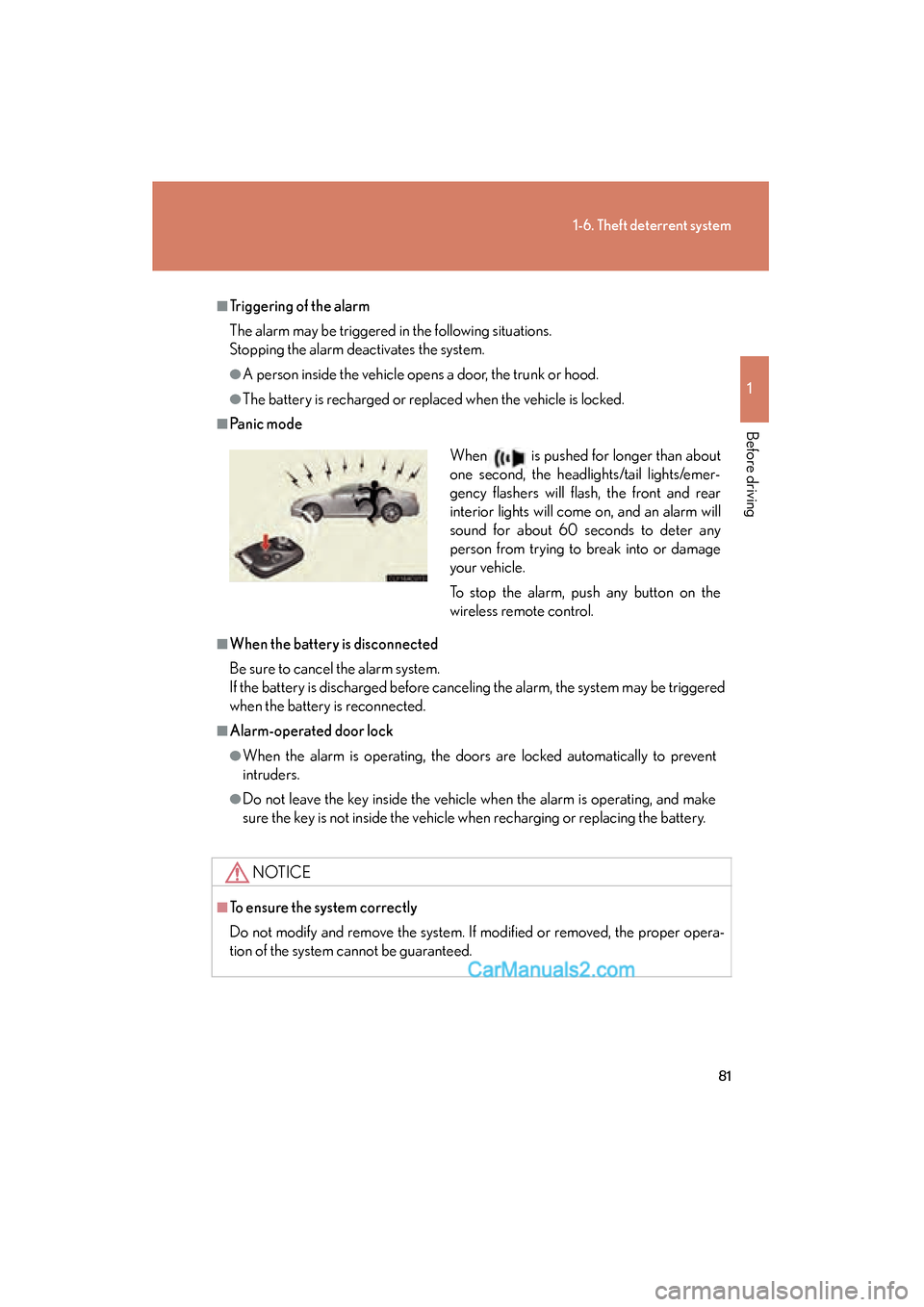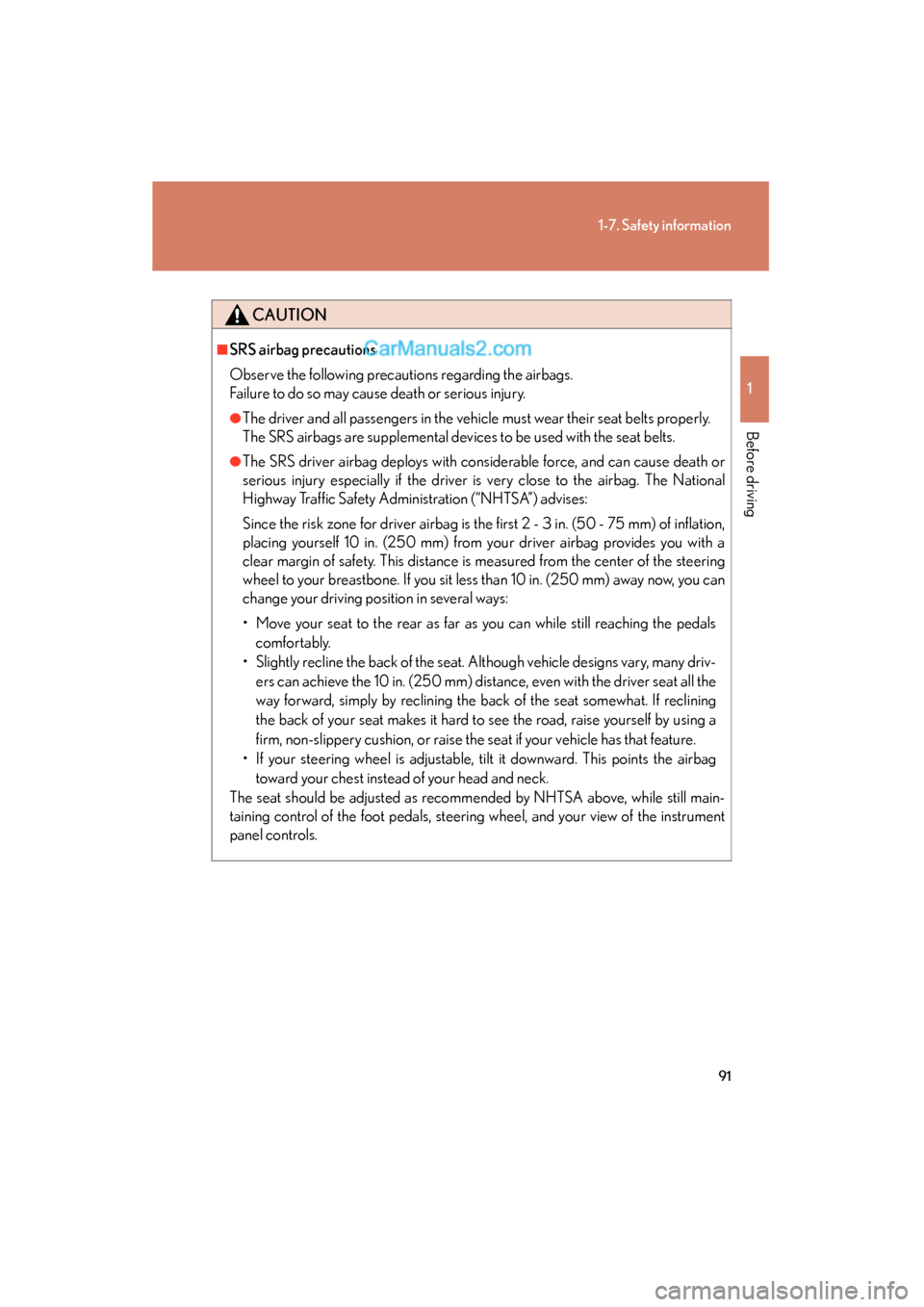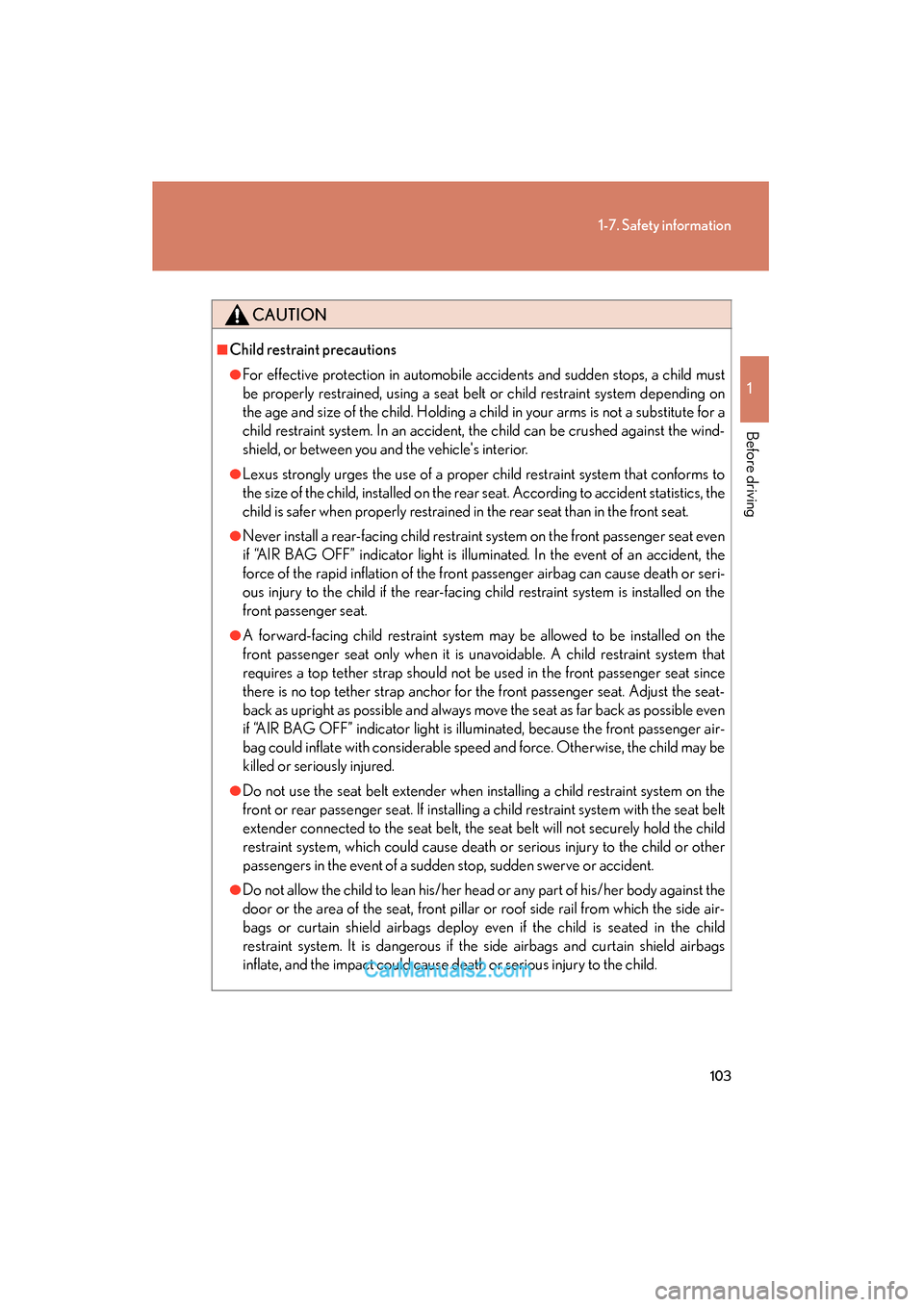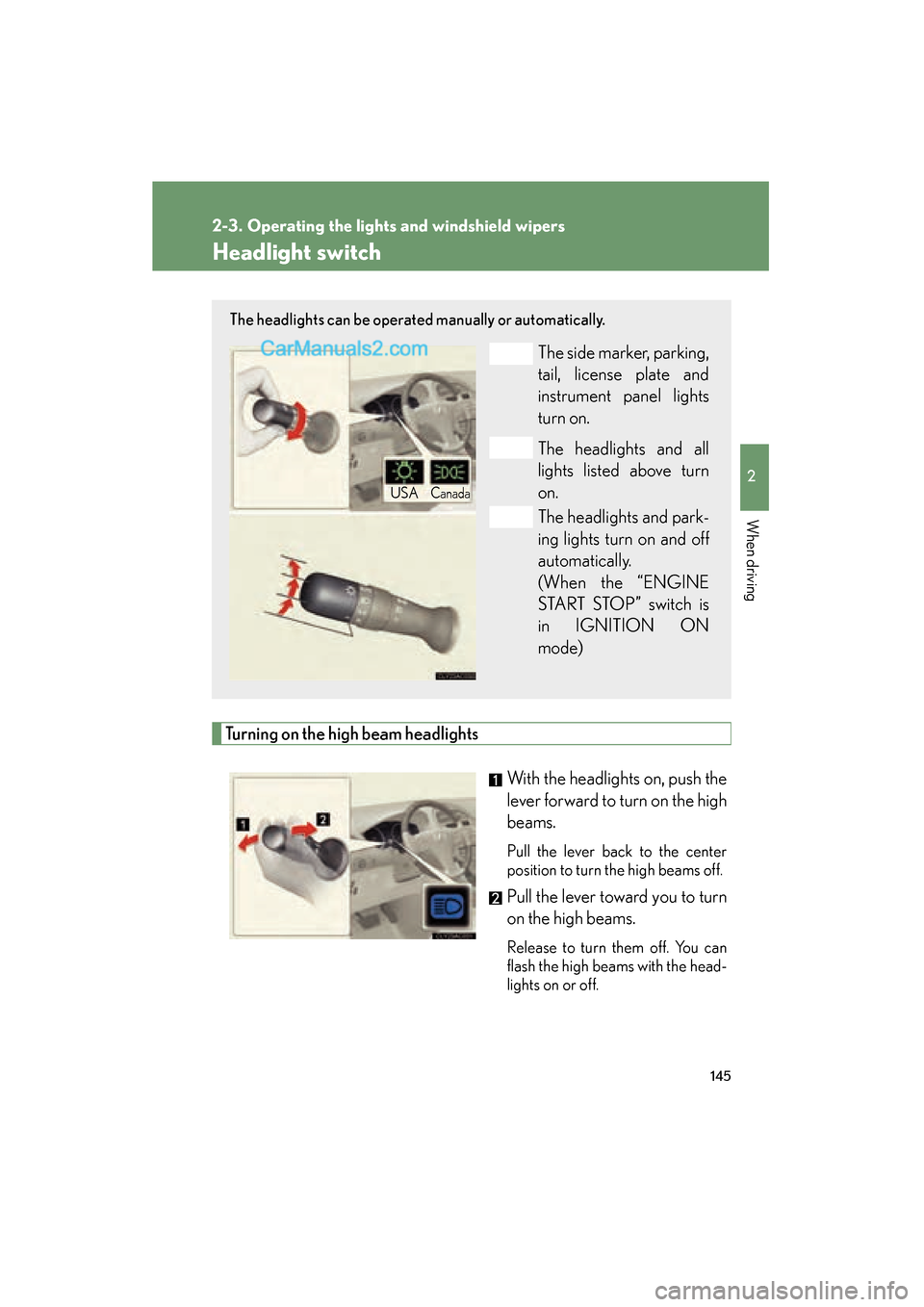2010 Lexus ES350 head light
[x] Cancel search: head lightPage 83 of 543

81
1-6. Theft deterrent system
1
Before driving
ES350_U
■Triggering of the alarm
The alarm may be triggered in the following situations.
Stopping the alarm deactivates the system.
●A person inside the vehicle opens a door, the trunk or hood.
●The battery is recharged or replaced when the vehicle is locked.
■Panic mode
■When the battery is disconnected
Be sure to cancel the alarm system.
If the battery is discharged before canceling the alarm, the system may be triggered
when the battery is reconnected.
■Alarm-operated door lock
●When the alarm is operating, the doors are locked automatically to prevent
intruders.
●Do not leave the key inside the vehicle when the alarm is operating, and make
sure the key is not inside the vehicle when recharging or replacing the battery.
NOTICE
■To ensure the system correctly
Do not modify and remove the system. If modified or removed, the proper opera-
tion of the system cannot be guaranteed.
When is pushed for longer than about
one second, the headlights/tail lights/emer-
gency flashers will flash, the front and rear
interior lights will come on, and an alarm will
sound for about 60 seconds to deter any
person from trying to break into or damage
your vehicle.
To stop the alarm, push any button on the
wireless remote control.
Page 93 of 543

91
1-7. Safety information
1
Before driving
ES350_U
CAUTION
■SRS airbag precautions
Observe the following precautions regarding the airbags.
Failure to do so may cause death or serious injury.
●The driver and all passengers in the vehicle must wear their seat belts properly.
The SRS airbags are supplemental devices to be used with the seat belts.
●The SRS driver airbag deploys with considerable force, and can cause death or
serious injury especially if the driver is very close to the airbag. The National
Highway Traffic Safety Administration (“NHTSA”) advises:
Since the risk zone for driver airbag is the first 2 - 3 in. (50 - 75 mm) of inflation,
placing yourself 10 in. (250 mm) from your driver airbag provides you with a
clear margin of safety. This distance is measured from the center of the steering
wheel to your breastbone. If you sit less than 10 in. (250 mm) away now, you can
change your driving position in several ways:
• Move your seat to the rear as far as you can while still reaching the pedalscomfortably.
• Slightly recline the back of the seat. Although vehicle designs vary, many driv- ers can achieve the 10 in. (250 mm) distance, even with the driver seat all the
way forward, simply by reclining the back of the seat somewhat. If reclining
the back of your seat makes it hard to see the road, raise yourself by using a
firm, non-slippery cushion, or raise the seat if your vehicle has that feature.
• If your steering wheel is adjustable, tilt it downward. This points the airbag toward your chest instead of your head and neck.
The seat should be adjusted as recommended by NHTSA above, while still main-
taining control of the foot pedals, steering wheel, and your view of the instrument
panel controls.
Page 105 of 543

103
1-7. Safety information
1
Before driving
ES350_U
CAUTION
■Child restraint precautions
●For effective protection in automobile accidents and sudden stops, a child must
be properly restrained, using a seat belt or child restraint system depending on
the age and size of the child. Holding a child in your arms is not a substitute for a
child restraint system. In an accident, the child can be crushed against the wind-
shield, or between you and the vehicle's interior.
●Lexus strongly urges the use of a proper child restraint system that conforms to
the size of the child, installed on the rear seat. According to accident statistics, the
child is safer when properly restrained in the rear seat than in the front seat.
●Never install a rear-facing child restraint system on the front passenger seat even
if “AIR BAG OFF” indicator light is illuminated. In the event of an accident, the
force of the rapid inflation of the front passenger airbag can cause death or seri-
ous injury to the child if the rear-facing child restraint system is installed on the
front passenger seat.
●A forward-facing child restraint system may be allowed to be installed on the
front passenger seat only when it is unavoidable. A child restraint system that
requires a top tether strap should not be used in the front passenger seat since
there is no top tether strap anchor for the front passenger seat. Adjust the seat-
back as upright as possible and always move the seat as far back as possible even
if “AIR BAG OFF” indicator light is illuminated, because the front passenger air-
bag could inflate with considerable speed and force. Otherwise, the child may be
killed or seriously injured.
●Do not use the seat belt extender when installing a child restraint system on the
front or rear passenger seat. If installing a child restraint system with the seat belt
extender connected to the seat belt, the seat belt will not securely hold the child
restraint system, which could cause death or serious injury to the child or other
passengers in the event of a sudden stop, sudden swerve or accident.
●Do not allow the child to lean his/her head or any part of his/her body against the
door or the area of the seat, front pillar or roof side rail from which the side air-
bags or curtain shield airbags deploy even if the child is seated in the child
restraint system. It is dangerous if the side airbags and curtain shield airbags
inflate, and the impact could cause death or serious injury to the child.
Page 117 of 543

When driving2
115
ES350_U
2-1. Driving proceduresDriving the vehicle................... 116
Engine (ignition) switch ......... 124
Automatic Transmission ........ 128
Turn signal lever ........................ 131
Parking brake ........................... 132
Horn ............................................ 133
2-2. Instrument cluster Gauges and meters ................ 134
Indicators and warning lights ......................................... 136
Multi-information display ..... 140
2-3. Operating the lights and windshield wipers
Headlight switch...................... 145
Fog light switch ........................ 148
Windshield wipers and washer ..................................... 149 2-4. Using other driving
systems
Cruise control.......................... 152
Dynamic radar cruise control ..................................... 155
Intuitive parking assist ........... 165
Driving assist systems .............. 171
PCS (Pre-Collision System) .................................... 176
2-5. Driving information Cargo and luggage ................ 180
Vehicle load limits ................... 183
Winter driving tips .................. 184
Trailer towing ........................... 190
Dinghy towing........................... 197
Page 121 of 543

119
2-1. Driving procedures
2
When driving
ES350_U
CAUTION
●Do not turn the engine off while driving.
The power steering and brake booster systems will not operate properly if the
engine is not running.
●Use engine braking (downshift) to maintain a safe speed when driving down a
steep hill.
Using the brakes continuously may cause the brakes to overheat and lose effec-
tiveness. (�oP. 1 2 8 )
●When stopped on an inclined surface, use the brake pedal and parking brake to
prevent the vehicle from rolling backward or forward and causing an accident.
●Do not adjust the position of the steering wheel, the seat, or the inside or outside
rear view mirrors while driving.
Doing so may result in a loss of vehicle control that can cause accidents that may
result in death or serious injury.
●Always check that all passengers' arms, heads or other parts of their bodies are
not outside the vehicle, as this may result in death or serious injury.
●Do not drive in excess of the speed limit. Even if the legal speed limit permits it, do
not drive over 85 mph (140 km/h) unless your vehicle has high-speed capability
tires. Driving over 85 mph (140 km/h) may result in tire failure, loss of control and
possible injury. Be sure to consult a tire dealer to determine whether the tires on
your vehicle are high-speed capability tires or not before driving at such speeds.
■When driving on slippery road surfaces
●Sudden braking, acceleration and steering may cause tire slippage and reduce
your ability to control the vehicle, resulting in an accident.
●Sudden changes in engine speed, such as engine braking caused by up-shifting
or down-shifting, may cause the vehicle to skid, resulting in an accident.
●After driving through a puddle, lightly depress the brake pedal to make sure that
the brakes are functioning properly. Wet brake pads may prevent the brakes from
functioning properly. If the brakes on only one side are wet and not functioning
properly, steering control may be affected, resulting in an accident.
■When shifting the shift lever
Be careful not to shift the shift lever with the accelerator pedal depressed.
This may lead to unexpected rapid acceleration of the vehicle that may cause an
accident and result in death or serious injury.
Page 137 of 543

135
2-2. Instrument cluster
2
When driving
ES350_U
Instrument panel light controlThe brightness of the instrument panel lights can be adjusted. Brighter
Darker
When the headlight switch is
turned to ON, the brightness will
be reduced slightly unless the con-
trol dial is turned fully up.
Odometer and trip meter
●Odometer
Displays the total distance the vehicle has been driven.
●Trip meter
Displays the distance the vehicle has been driven since the meter was
last reset. Trip meters A and B can be used to record and display differ-
ent distances independently.
Engine coolant temperature gauge
Displays the engine coolant temperature.
NOTICE
■To prevent damage to the engine and its components
●Do not let the indicator needle of the tachometer enter the red zone, which indi-
cates the maximum engine speed.
●The engine may be overheating if the temperature gauge is in the red zone (H). In
this case, immediately stop the vehicle in a safe place, and check the engine after
it has cooled completely. ( �oP. 4 8 0 )
Page 140 of 543

138
2-2. Instrument cluster
ES350_U
■Indicators
The indicators inform the driver of the operating state of the vehi-
cle’s various systems.
Turn signal indicator
(�o P. 131)
(if equipped)
AFS OFF indicator light
(�o P. 146)
Headlight high beam indi-
cator ( �oP. 1 4 5 )Slip indicator ( �oP. 171)
(USA)
Headlight indicator
(�o P. 1 4 5 )VSC off indicator
(�o P. 1 7 2 )
(Canada)
Tail light indicator
(�o P. 1 4 5 )
(without
navigation
system)
SRS airbag on-off indica-
tor (�o P. 9 6 )
Front fog light indicator
(�o P. 1 4 8 )
(with navi-
gation sys-
tem)
SRS airbag on-off indica-
tor (�o P. 9 6 )
Eco Driving Indicator
Light (�oP. 1 4 4 )
Shift position and shift range indica-
tors ( �o
P. 1 2 8)
Cruise control indicator
(�o P. 152, 155)
Cruise control “SET” indi-
cator ( �oP. 152, 155)
(if equipped)
Radar cruise control indi-
cator ( �oP. 1 5 5 )
*
*
*
*
*
*
Page 147 of 543

145
2
When driving
ES350_U
2-3. Operating the lights and windshield wipers
Headlight switch
Turning on the high beam headlightsWith the headlights on, push the
lever forward to turn on the high
beams.
Pull the lever back to the center
position to turn the high beams off.
Pull the lever toward you to turn
on the high beams.
Release to turn them off. You can
flash the high beams with the head-
lights on or off.
The headlights can be operated manually or automatically.
The side marker, parking,
tail, license plate and
instrument panel lights
turn on.
The headlights and all
lights listed above turn
on.
The headlights and park-
ing lights turn on and off
automatically.
(When the “ENGINE
START STOP” switch is
in IGNITION ON
mode)
USACanada